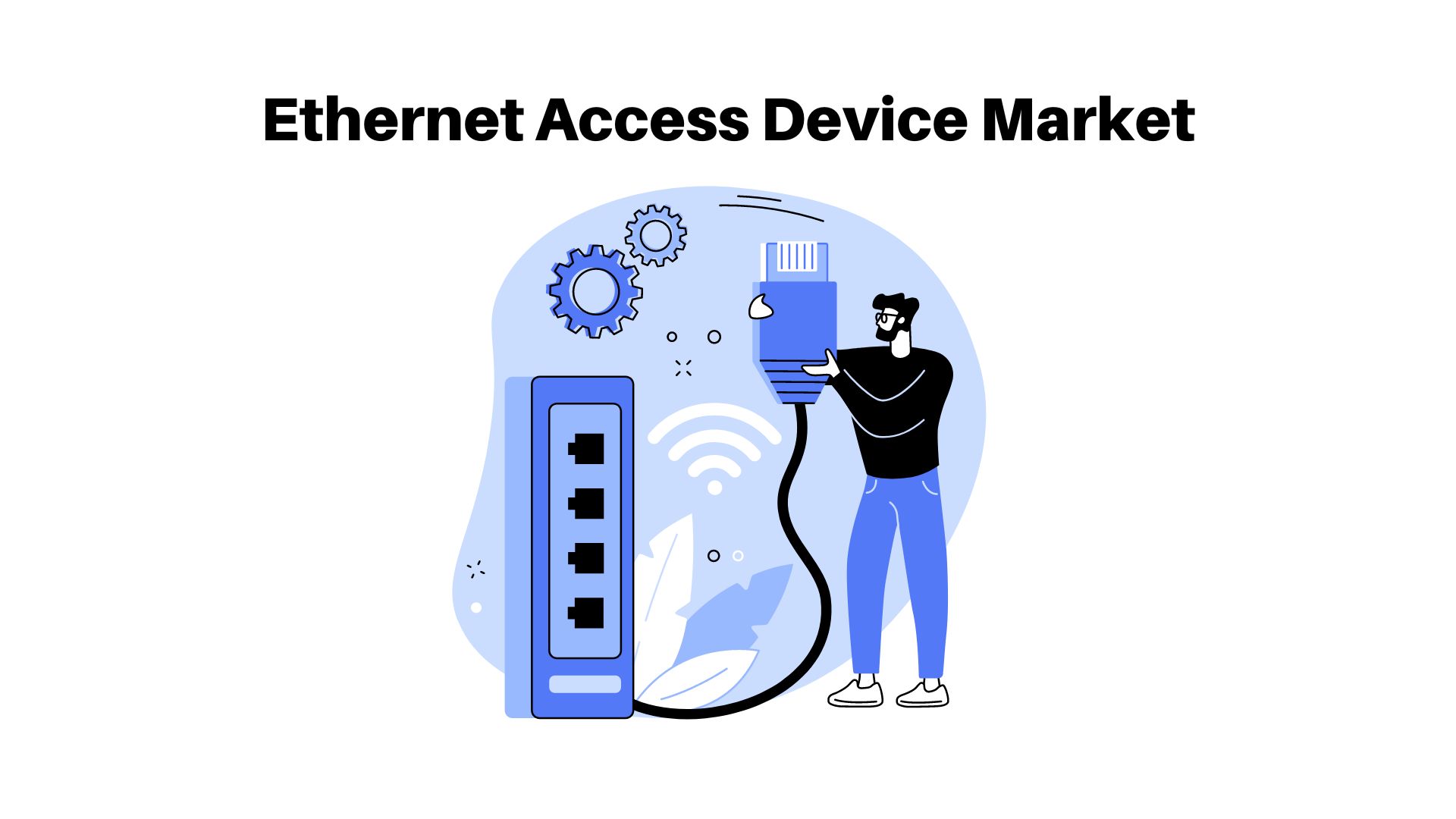Ethernet Access Device Market is Estimated to Showcase Significant Growth of USD 12.56 Bn in 2032 With a CAGR 4.2%

Page Contents
Market Overview
By 2032, the global Ethernet Access Device market size is expected to reach USD 19.0 Bn from USD 12.56 Bn in 2022, rising at a compound annual growth rate (CAGR) of 4.2% from 2023-2032.
Ethernet Access Device (EAD) is a device that creates an Ethernet connection between customer premises equipment and a carrier's network, delivering Ethernet services to end-users. They're commonly used in applications like mobile backhaul, business services, and residential broadband connections. The Ethernet Access Device market is expected to experience significant growth over the coming years due to increased demand for high-speed broadband internet services as well as cloud-based offerings.
The Ethernet Access Device market is being driven by the increasing demand for high-speed internet, the rising adoption of cloud-based services, and an ever-increasing number of internet users. Furthermore, fiber-optic networks' increasing deployment and 5G technology's expected to further fuel its expansion over the coming years.
Geographically, the Asia-Pacific region was expected to dominate the Ethernet Access Device market during the forecast period due to rising demand for high-speed internet connectivity in countries like China and India. North America and Europe were also anticipated as significant markets due to the large number of internet service providers present there.

Drivers, trends, and challenges have an impact on market dynamics, which can impact businesses. Request for PDF sample report
Key Takeaways
- The Ethernet Access Device market is expected to experience significant growth over the coming years due to the increasing demand for high-speed broadband services and the adoption of cloud-based solutions.
- Ethernet Access Devices have many applications, from mobile backhaul and business services to residential broadband.
- North America is expected to dominate the Ethernet Access Device market owing to a number of prominent players located there.
- Some of the leading players in the Ethernet Access Device market include ADVA Optical Networking SE, Ciena Corporation, Huawei Technologies Co. Ltd., Nokia Corporation, and ZTE Corporation.
Regional Snapshot
- North America is expected to lead the Ethernet Access Device market due to the presence of several prominent players there.
- Asia-Pacific is projected to experience the highest compound annual growth rate due to the increasing demand for high-speed broadband services and the adoption of cloud-based services within the region.
- Europe is expected to experience significant growth due to the increasing adoption of cloud-based services and the demand for high-speed broadband in the region.
Market Dynamics
Drivers
A number of factors are propelling the growth of the Ethernet Access Device market. These drivers include:
Increased Demand for High-Speed Internet Connectivity: As more businesses and individuals require fast internet connections, the demand for Ethernet Access Devices has grown. Ethernet-based networks are renowned for their speedy capabilities, making them ideal for those who require fast connections.
Adoption of cloud-based services: Cloud adoption has seen huge growth in recent years. To take advantage of these services, fast and dependable internet connections are necessary – something that can be provided by Ethernet Access Devices.
Increased Number of Internet Users: With the ever-increasing number of internet users worldwide, internet service providers must offer high-speed connectivity to their customers. Ethernet Access Devices enable ISPs to deliver fast and dependable connections.
Deployment of fiber-optic networks: Fiber optic networks are becoming more commonplace due to their faster internet speeds and greater dependability compared to traditional copper-based networks. Ethernet Access Devices are commonly used to connect businesses and individuals to these networks.
Adoption of 5G Technology: The adoption of 5G technology is anticipated to propel the growth of the Ethernet Access Device market over the coming years. 5G networks require high-speed connectivity, which can be provided by Ethernet Access Devices.
Restraints
While the Ethernet Access Device market is expected to experience growth over the coming years, certain restraints could limit its expansion. These could include:
High Deployment Costs: Ethernet Access Devices can be expensive to deploy, especially for small businesses or individuals who lack the financial capacity to invest in them. This may hinder their adoption, particularly in developing countries.
Competition from wireless technologies: Although Ethernet-based networks offer high-speed connectivity, their expansion can be hindered by physical infrastructure limitations. Wireless technologies such as Wi-Fi and cellular networks offer greater freedom and cost efficiency, potentially constraining the growth of the Ethernet Access Device market.
Lack of Awareness and Technical Capability: Many businesses and individuals may not be aware of the advantages of Ethernet Access Devices, or lack the technical know-how to install and maintain them. This could limit adoption rates among smaller firms and individuals alike.
Opportunities
The Ethernet Access Device market presents numerous opportunities. Some of these prospects include:
Increasing demand for smart homes and cities: As more people adopt these technologies, the demand for Ethernet Access Devices is expected to grow. These applications require high-speed, dependable connectivity – which can only be provided by Ethernet-based networks.
Emerging Markets: The Ethernet Access Device market is expected to experience significant growth in emerging regions such as Asia-Pacific, Latin America, and Africa due to the increasing demand for high-speed internet connections and the adoption of advanced technologies like 5G. These regions are projected to drive market expansion through these channels.
Adoption of the Internet of Things (IoT): As the adoption of IoT devices grows rapidly, they require reliable and fast internet connectivity. Ethernet Access Devices provide this capability, creating an opportunity for those in the Ethernet Access Device market.
Cloud Computing: Cloud computing is becoming more and more popular, and Ethernet Access Devices can provide the fast and dependable connectivity necessary to access cloud-based services.
Rising Demand for Video Streaming: As more people take advantage of streaming services like Netflix and Amazon Prime Video, there is an increasing need for high-speed internet connection. Ethernet Access Devices offer this fast and dependable connection so you can watch HD-quality video content with ease.
Challenges
The Ethernet Access Device market could face numerous difficulties over the coming years, including:
Compatibility with Legacy Systems: Many businesses and individuals may have existing legacy systems that are incompatible with Ethernet Access Devices, potentially hindering their adoption of these devices in companies that have already invested heavily in their current setups.
Cybersecurity Risks: As Ethernet-based networks become more commonplace, they may become vulnerable to cyberattacks. This could compromise the security of data transmitted over these networks and hinder the adoption of Ethernet Access Devices.
Complexity: Ethernet Access Devices can be difficult to set up and manage, especially for smaller businesses or individuals who lack the technical know-how.
Lack of Standardization: Lacking standardization in Ethernet-based networks could restrict interoperability among different Ethernet Access Devices and make it difficult for businesses and individuals to select the suitable device for their requirements.
Recent Developments
- On March 20, 2021, ADVA Optical Networking SE released their FSP 150-XG118Pro Ethernet Access Device that offers high-speed connectivity and low latency
- In February 2021, Nokia Corporation unveiled their Altiplano Access Controller, designed to give service providers control and deployment of Ethernet and IP services.
Key Market Segments
Type
- 1 GbE
- 10 GbE
- 40 GbE
- 100 GbE
- Others
Application
- Residential
- Commercial
- Industrial
- Government
- Others
Key Market Players
- Cisco Systems
- Juniper Networks
- Alcatel-Lucent Enterprise
- Arista Networks
- Brocade Communications Systems
- Dell
- HPE
- Ericsson
- Huawei
- NEC
- NETGEAR
- Moxa
- Oracle
- RAD
- Siemens
- ZTE
- Allied Telesis
- Advantech B+B SmartWorx
- Telco Systems
- Westermo (Beijer Electronics Group)
Report Scope
| Report Attribute | Details |
| The market size value in 2022 | USD 12.56 Bn |
| Revenue forecast by 2032 | USD 19.0 Bn |
| Growth Rate | CAGR Of 4.2% |
| Regions Covered | North America, Europe, Asia Pacific, Latin America, and Middle East & Africa, and Rest of the World |
| Historical Years | 2017-2022 |
| Base Year | 2022 |
| Estimated Year | 2023 |
| Short-Term Projection Year | 2028 |
| Long-Term Projected Year | 2032 |
Frequently Asked Questions
Q: What is an Ethernet Access Device?
A: An Ethernet Access Device (EAD) is a device that provides a connection between customer premises equipment and a carrier's network, allowing the delivery of Ethernet services to end-users.
Q: What are the key applications of Ethernet Access Devices?
A: Some of the key applications of Ethernet Access Devices include mobile backhaul, business services, and residential broadband.
Q: What are the drivers of the Ethernet Access Device market?
A: The drivers of the Ethernet Access Device market include increasing demand for high-speed broadband services, adoption of cloud-based services, growing need for mobile backhaul, and increasing demand for business services.
Q: What are the restraints of the Ethernet Access Device market?
A: The restraints of the Ethernet Access Device market include high initial investment costs and security concerns related to cloud-based services.
Q: What are the opportunities in the Ethernet Access Device market?
A: The opportunities in the Ethernet Access Device market include growing demand for internet of things (IoT) devices and increasing demand for 5G networks.
Q: What are the recent developments in the Ethernet Access Device market?
A: Some of the recent developments in the Ethernet Access Device market include ADVA Optical Networking SE launching its FSP 150-XG118Pro Ethernet Access Device
The team behind market.us, marketresearch.biz, market.biz and more. Our purpose is to keep our customers ahead of the game with regard to the markets. They may fluctuate up or down, but we will help you to stay ahead of the curve in these market fluctuations. Our consistent growth and ability to deliver in-depth analyses and market insight has engaged genuine market players. They have faith in us to offer the data and information they require to make balanced and decisive marketing decisions.



